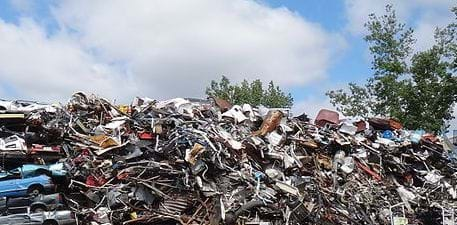Quick Look
Grade Level: 9 (8-10)
Time Required: 15 minutes
Lesson Dependency: None
Subject Areas: Science and Technology

Summary
Students begin working on the grand challenge of the unit by thinking about the nature of metals and quick, cost-effective means of separating different metals, especially steel. They arrive at the idea, with the help of input from relevant sources, to use magnets, but first they must determine if the magnets can indeed isolate only the steel.Engineering Connection
This lesson pertains to engineering design specifications. In the associated activity, students have a set of design parameters (pick up steel, not aluminum) and must identify possible solutions that can achieve these parameters. Then they pare down the list of possible solutions based on efficacy and affordability. These guiding principles are common in the engineering desig approach.
Learning Objectives
After this lesson, students should be able to:
- Explain how magnets can be used to separate different metals.
- Identify metals that respond to magnets.
- Explain how engineers use properties of magnets in everyday applications.
Educational Standards
Each TeachEngineering lesson or activity is correlated to one or more K-12 science,
technology, engineering or math (STEM) educational standards.
All 100,000+ K-12 STEM standards covered in TeachEngineering are collected, maintained and packaged by the Achievement Standards Network (ASN),
a project of D2L (www.achievementstandards.org).
In the ASN, standards are hierarchically structured: first by source; e.g., by state; within source by type; e.g., science or mathematics;
within type by subtype, then by grade, etc.
Each TeachEngineering lesson or activity is correlated to one or more K-12 science, technology, engineering or math (STEM) educational standards.
All 100,000+ K-12 STEM standards covered in TeachEngineering are collected, maintained and packaged by the Achievement Standards Network (ASN), a project of D2L (www.achievementstandards.org).
In the ASN, standards are hierarchically structured: first by source; e.g., by state; within source by type; e.g., science or mathematics; within type by subtype, then by grade, etc.
International Technology and Engineering Educators Association - Technology
-
Conduct research to inform intentional inventions and innovations that address specific needs and wants.
(Grades
9 -
12)
More Details
Do you agree with this alignment?
State Standards
Tennessee - Science
-
Explain the relationship between the properties of a material and the use of the material in the application of a technology.
(Grades
9 -
12)
More Details
Do you agree with this alignment?
-
Explain the relationship between the properties of a material and the use of the material in the application of a technology.
(Grades
9 -
12)
More Details
Do you agree with this alignment?
-
Understand magnetic poles, magnetic fields, and investigate electromagnetic induction.
(Grades
9 -
12)
More Details
Do you agree with this alignment?
Worksheets and Attachments
Visit [www.teachengineering.org/lessons/view/van_cleanupmess_less1] to print or download.Pre-Req Knowledge
An understanding of basic chemical and physical properties of different metals and differences among those properties.
Introduction/Motivation
Congratulations, you have just been hired by the recycling company to streamline their sorting process. And, by streamline a sorting process, I mean you have a room full of metal (show picture of scrap metal in Figure 1) that you need to sort into valuable steel, and considerably less valuable aluminum. (Hand out the Challenge Sheet and give students time to read it.) You will be paid based on how much steel you can remove from this room per day. Remember, truckloads of mixed scrap metal will arrive daily, so you must be able to separate it efficiently. What are some ways to separate the steel from the aluminum? (Write suggestions on the classroom board and then discuss each option. Possible suggestions include magnets and manual labor. Be sure students understand that manual labor is an expensive, slow option that results in plenty of error. Be sure they understand that magnets may pick up steel, but allow for the possibility that they will also pick up aluminum. This last point helps in the transition to the associated activity.)
If a magnet is a possibility, we need to make sure we know what materials it will affect. (Next, conduct the Magnetic or Not? activity).
Lesson Background and Concepts for Teachers
Legacy Cycle Information
This lesson opens the legacy cycle with the challenge and immediately incorporates the Generate Ideas and Multiple Perspectives phases in order to focus on the possibility of a magnet only affecting steel. This sets students up for the idea that a magnet only affects iron (or nickel) based materials, making it ideal for picking up only the steel. This idea will be built upon later so that students realize a magnet that can be turned off (an electromagnet) is ideal for both lifting and dropping large quantities of steel quickly.
Lecture information
Engineers have used the scientific concept of magnets to design devices that separate steel from aluminum. Magnets are ideal for separating steel from aluminum because they only pick up iron or nickel based substances. While magnetic fields affect all substances to a small degree, the nature of iron and nickel make these metals strongly responsive to outside magnetic fields. Aluminum and most other metals do not respond as such. Manual labor, while effective for separating aluminum from steel, is more expensive due to the cost of paying people to do the work, slower because it requires each piece of metal to be identified by the laborers, and less accurate because it relies on a fallible judgment.

Associated Activities
- Magnetic or Not? - Students explore which materials are magnetic and which are not, which helps them begin to think about the challenge of separating materials by the use of magnets.
Lesson Closure
(After completing the associated activity, Magnetic or Not?) Will a magnet separate steel from aluminum? (Expect to receive a unanimous yes from students.) Why? (Direct students to the fact that steel is magnetic but aluminum is not; only the steel is attracted to the magnet leaving the aluminum on the floor.) An overhead magnet, possibly attached to a crane, would allow us to pick up many pieces of steel while leaving the aluminum.
Vocabulary/Definitions
steel: A metal formed of a solid mixture of iron and carbon.
Assessment
Questions: Use the Lesson Closure questions as informal assessment to gauge student understanding of the material and defined challenge.
Subscribe
Get the inside scoop on all things TeachEngineering such as new site features, curriculum updates, video releases, and more by signing up for our newsletter!More Curriculum Like This

The grand challenge for this legacy cycle unit is for students to design a way to help a recycler separate aluminum from steel scrap metal. In previous lessons, they looked at how magnetism might be utilized.

Students complete the grand challenge of this unit and design an electromagnet to separate steel from aluminum for a recycler. In order to do this, they compare the induced magnetic field of an electric current with the magnetic field of a permanent magnet and then make the former look like the latt...

Students induce EMF in a coil of wire using magnetic fields. Students review the cross product with respect to magnetic force and introduce magnetic flux, Faraday's law of Induction, Lenz's law, eddy currents, motional EMF and Induced EMF.

Students explore the basic magnetic properties of different substances, particularly aluminum and steel. There is a common misconception that magnets attract all metals, largely due to the ubiquity of steel in metal products.
Copyright
© 2013 by Regents of the University of Colorado; original © 2011 Vanderbilt UniversityContributors
Justin Montenegro , Glencliff High School, NashvilleSupporting Program
VU Bioengineering RET Program, School of Engineering, Vanderbilt UniversityAcknowledgements
The contents of this digital library curriculum were developed under National Science Foundation RET grant nos. 0338092 and 0742871. However, these contents do not necessarily represent the policies of the NSF, and you should not assume endorsement by the federal government.
Last modified: September 5, 2017









User Comments & Tips